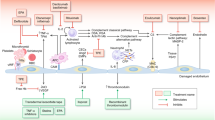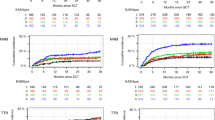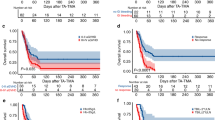Abstract
There is increasing evidence that endothelial dysfunction is involved in refractoriness of acute GvHD (aGvHD). Here we investigated the hypothesis that another endothelial complication, transplant-associated thrombotic microangiopathy (TMA), contributes to the pathogenesis of aGvHD refractoriness. TMA was retrospectively assessed in 771 patients after allogeneic stem cell transplantation (alloSCT). Incidences of TMA and refractory aGvHD were correlated with biomarkers of endothelial damage obtained before alloSCT for patients receiving or not receiving statin-based endothelial prophylaxis (SEP). Diagnostic criteria for TMA and refractory aGvHD were met by 41 (5.3%) and 76 (10%) patients, respectively. TMA was overrepresented in patients with refractory aGvHD (45.0 vs 2.3% in all other patients, P<0.001). TMA independently increased mortality. Elevated pretransplant suppressor of tumorigenicity-2 and nitrates along with high-risk variants of the thrombomodulin gene were associated with increased risk of TMA. In contrast, SEP abolished the unfavorable outcome predicted by pretransplant biomarkers on TMA risk. Patients on SEP had a significantly lower risk of TMA (P=0.001) and refractory aGvHD (P=0.055) in a multivariate multistate model. Our data provide evidence that TMA contributes to the pathogenesis of aGvHD refractoriness. Patients with an increased TMA risk can be identified pretransplant and may benefit from pharmacological endothelium protection.
This is a preview of subscription content, access via your institution
Access options
Subscribe to this journal
Receive 12 print issues and online access
$259.00 per year
only $21.58 per issue
Buy this article
- Purchase on Springer Link
- Instant access to full article PDF
Prices may be subject to local taxes which are calculated during checkout



Similar content being viewed by others
References
Ferrara JL, Levine JE, Reddy P, Holler E . Graft-versus-host disease. Lancet 2009; 373: 1550–1561.
Westin JR, Saliba RM, De Lima M, Alousi A, Hosing C, Qazilbash MH et al. Steroid-refractory acute GVHD: predictors and outcomes. Adv Hematol 2011; 2011: 601953.
Luft T, Dietrich S, Falk C, Conzelmann M, Hess M, Benner A et al. Steroid-refractory GVHD: T-cell attack within a vulnerable endothelial system. Blood 2011; 118: 1685–1692.
Dietrich S, Falk CS, Benner A, Karamustafa S, Hahn E, Andrulis M et al. Endothelial vulnerability and endothelial damage are associated with risk of graft-versus-host disease and response to steroid treatment. Biol Blood Marrow Transplant 2013; 19: 22–27.
Dietrich S, Okun JG, Schmidt K, Falk CS, Wagner AH, Karamustafa S et al. High pre-transplant serum nitrate levels predict risk of acute steroid-refractory graft-versus-host disease in the absence of statin therapy. Haematologica 2014; 99: 541–547.
Rachakonda SP, Penack O, Dietrich S, Blau O, Blau IW, Radujkovic A et al. Single-nucleotide polymorphisms within the thrombomodulin gene (THBD) predict mortality in patients with graft-versus-host disease. J Clin Oncol 2014; 32: 3421–3427.
George JN, Li X, McMinn JR, Terrell DR, Vesely SK, Selby GB . Thrombotic thrombocytopenic purpura-hemolytic uremic syndrome following allogeneic HPC transplantation: a diagnostic dilemma. Transfusion 2004; 44: 294–304.
Changsirikulchai S, Myerson D, Guthrie KA, McDonald GB, Alpers CE, Hingorani SR . Renal thrombotic microangiopathy after hematopoietic cell transplant: role of GVHD in pathogenesis. Clin J Am Soc Nephrol 2009; 4: 345–353.
Jodele S, Laskin BL, Dandoy CE, Myers KC, El-Bietar J, Davies SM et al. A new paradigm: diagnosis and management of HSCT-associated thrombotic microangiopathy as multi-system endothelial injury. Blood Rev 2015; 29: 191–204.
Laskin BL, Goebel J, Davies SM, Jodele S . Small vessels, big trouble in the kidneys and beyond: hematopoietic stem cell transplantation-associated thrombotic microangiopathy. Blood 2011; 118: 1452–1462.
Vander Lugt MT, Braun TM, Hanash S, Ritz J, Ho VT, Antin JH et al. ST2 as a marker for risk of therapy-resistant graft-versus-host disease and death. N Engl J Med 2013; 369: 529–539.
Demyanets S, Kaun C, Pentz R, Krychtiuk KA, Rauscher S, Pfaffenberger S et al. Components of the interleukin-33/ST2 system are differentially expressed and regulated in human cardiac cells and in cells of the cardiac vasculature. J Mol Cell Cardiol 2013; 60: 16–26.
Pascual-Figal DA, Januzzi JL . The biology of ST2: the International ST2 Consensus Panel. Am J Cardiol 2015; 115 (7 Suppl): 3B–7B.
Aldous SJ, Richards AM, Troughton R, Than M . ST2 has diagnostic and prognostic utility for all-cause mortality and heart failure in patients presenting to the emergency department with chest pain. J Card Fail 2012; 18: 304–310.
Reichenbach DK, Schwarze V, Matta BM, Tkachev V, Lieberknecht E, Liu Q et al. The IL-33/ST2 axis augments effector T-cell responses during acute GVHD. Blood 2015; 125: 3183–3192.
Glucksberg H, Storb R, Fefer A, Buckner CD, Neiman PE, Clift RA et al. Clinical manifestations of graft-versus-host disease in human recipients of marrow from HL-A-matched sibling donors. Transplantation 1974; 18: 295–304.
Rovo A, Tichelli A, Late Effects Working Party of the European Group for B, Marrow T . Cardiovascular complications in long-term survivors after allogeneic hematopoietic stem cell transplantation. Semin Hematol 2012; 49: 25–34.
Cheuk DK, Chiang AK, Ha SY, Chan GC . Interventions for prophylaxis of hepatic veno-occlusive disease in people undergoing haematopoietic stem cell transplantation. Cochrane Database Syst Rev 2015; 5: CD009311.
Ho VT, Cutler C, Carter S, Martin P, Adams R, Horowitz M et al. Blood and marrow transplant clinical trials network toxicity committee consensus summary: thrombotic microangiopathy after hematopoietic stem cell transplantation. Biol Blood Marrow Transplant 2005; 11: 571–575.
Ruutu T, Barosi G, Benjamin RJ, Clark RE, George JN, Gratwohl A et al. Diagnostic criteria for hematopoietic stem cell transplant-associated microangiopathy: results of a consensus process by an International Working Group. Haematologica 2007; 92: 95–100.
National Kidney F. K/DOQI clinical practice guidelines for chronic kidney disease: evaluation, classification, and stratification. Am J Kidney Dis 2002; 39 (2 Suppl 1): S1–266.
Simon R, Makuch RW . A non-parametric graphical representation of the relationship between survival and the occurrence of an event: application to responder versus non-responder bias. Stat Med 1984; 3: 35–44.
Grambsch PM, Therneau TM, Fleming TR . Diagnostic plots to reveal functional form for covariates in multiplicative intensity models. Biometrics 1995; 51: 1469–1482.
Putter H, Fiocco M, Geskus RB . Tutorial in biostatistics: competing risks and multi-state models. Stat Med 2007; 26: 2389–2430.
Holländer N, Sauerbrei W, Schumacher M . Confidence intervals for the effect of a prognostic factor after selection of an 'optimal' cutpoint. Stat Med 2004; 23: 1701–1713.
Peyvandi F, Siboni SM, Lambertenghi Deliliers D, Lavoretano S, De Fazio N, Moroni B et al. Prospective study on the behaviour of the metalloprotease ADAMTS13 and of von Willebrand factor after bone marrow transplantation. Br J Haematol 2006; 134: 187–195.
Elsallabi O, Bhatt VR, Dhakal P, Foster KW, Tendulkar KK . Hematopoietic stem cell transplant-associated thrombotic microangiopathy. Clin Appl Thromb Hemost 2016; 22: 12–20.
Inamoto Y, Ito M, Suzuki R, Nishida T, Iida H, Kohno A et al. Clinicopathological manifestations and treatment of intestinal transplant-associated microangiopathy. Bone Marrow Transplant 2009; 44: 43–49.
Nishida T, Hamaguchi M, Hirabayashi N, Haneda M, Terakura S, Atsuta Y et al. Intestinal thrombotic microangiopathy after allogeneic bone marrow transplantation: a clinical imitator of acute enteric graft-versus-host disease. Bone Marrow Transplant 2004; 33: 1143–1150.
Chapin J, Shore T, Forsberg P, Desman G, Van Besien K, Laurence J . Hematopoietic transplant-associated thrombotic microangiopathy: case report and review of diagnosis and treatments. Clin Adv Hematol Oncol 2014; 12: 565–573.
Batts ED, Lazarus HM . Diagnosis and treatment of transplantation-associated thrombotic microangiopathy: real progress or are we still waiting? Bone Marrow Transplant 2007; 40: 709–719.
Jodele S, Davies SM, Lane A, Khoury J, Dandoy C, Goebel J et al. Diagnostic and risk criteria for HSCT-associated thrombotic microangiopathy: a study in children and young adults. Blood 2014; 124: 645–653.
Ito S, Barrett AJ . ST2: the biomarker at the heart of GVHD severity. Blood 2015; 125: 10–11.
Miller AM, Xu D, Asquith DL, Denby L, Li Y, Sattar N et al. IL-33 reduces the development of atherosclerosis. J Exp Med 2008; 205: 339–346.
Sánchez-Más J, Lax A, Asensio-López Mdel C, Fernandez-Del Palacio MJ, Caballero L, Santarelli G et al. Modulation of IL-33/ST2 system in postinfarction heart failure: correlation with cardiac remodelling markers. Eur J Clin Invest 2014; 44: 643–651.
Coglianese EE, Larson MG, Vasan RS, Ho JE, Ghorbani A, McCabe EL et al. Distribution and clinical correlates of the interleukin receptor family member soluble ST2 in the Framingham Heart Study. Clin Chem 2012; 58: 1673–1681.
Wang TJ, Wollert KC, Larson MG, Coglianese E, McCabe EL, Cheng S et al. Prognostic utility of novel biomarkers of cardiovascular stress: the Framingham Heart Study. Circulation 2012; 126: 1596–1604.
Bartunek J, Delrue L, Van Durme F, Muller O, Casselman F, De Wiest B et al. Nonmyocardial production of ST2 protein in human hypertrophy and failure is related to diastolic load. J Am Coll Cardiol 2008; 52: 2166–2174.
Ponce DM, Hilden P, Mumaw C, Devlin SM, Lubin M, Giralt S et al. High day 28 ST2 levels predict for acute graft-versus-host disease and transplant-related mortality after cord blood transplantation. Blood 2015; 125: 199–205.
Kwak B, Mulhaupt F, Myit S, Mach F . Statins as a newly recognized type of immunomodulator. Nat Med 2000; 6: 1399–1402.
Ridker PM, Rifai N, Pfeffer MA, Sacks F, Braunwald E . Long-term effects of pravastatin on plasma concentration of C-reactive protein. The Cholesterol and Recurrent Events (CARE) Investigators. Circulation 1999; 100: 230–235.
Amuro H, Ito T, Miyamoto R, Sugimoto H, Torii Y, Son Y et al. Statins, inhibitors of 3-hydroxy-3-methylglutaryl-coenzyme A reductase, function as inhibitors of cellular and molecular components involved in type I interferon production. Arthritis Rheum 2010; 62: 2073–2085.
Sato K, Nuki T, Gomita K, Weyand CM, Hagiwara N . Statins reduce endothelial cell apoptosis via inhibition of TRAIL expression on activated CD4 T cells in acute coronary syndrome. Atherosclerosis 2010; 213: 33–39.
Wang CY, Liu PY, Liao JK . Pleiotropic effects of statin therapy: molecular mechanisms and clinical results. Trends Mol Med 2008; 14: 37–44.
Casey RG, Joyce M, Roche-Nagle G, Chen G, Bouchier-Hayes D . Pravastatin modulates early diabetic nephropathy in an experimental model of diabetic renal disease. J Surg Res 2005; 123: 176–181.
Úriz M, Sáez E, Prieto J, Medina JF, Banales JM . Ursodeoxycholic acid is conjugated with taurine to promote secretin-stimulated biliary hydrocholeresis in the normal rat. PLoS ONE 2011; 6: e28717.
Ruutu T, Juvonen E, Remberger M, Remes K, Volin L, Mattsson J et al. Improved survival with ursodeoxycholic acid prophylaxis in allogeneic stem cell transplantation: long-term follow-up of a randomized study. Biol Blood Marrow Transplant 2014; 20: 135–138.
Acknowledgements
We thank Michael Hess and Alexandra Hof for excellent technical assistance, Maria Gawlik for excellent study assistance, Claire Gustafson for the excellent linguistic review of the manuscript and the central laboratory of the University Hospital Heidelberg for measuring routine blood values.
Author contributions
M Zeisbrich, AR, KS, JB, AH, M Zeier and PD performed research and wrote the paper. NB and AB analyzed the data and wrote the paper. TL designed the study, performed research, analyzed the data and wrote the paper. M Zeisbrich designed this study.
Author information
Authors and Affiliations
Corresponding author
Ethics declarations
Competing interests
The authors declare no conflict of interest.
Additional information
Supplementary Information accompanies this paper on Bone Marrow Transplantation website
Supplementary information
Rights and permissions
About this article
Cite this article
Zeisbrich, M., Becker, N., Benner, A. et al. Transplant-associated thrombotic microangiopathy is an endothelial complication associated with refractoriness of acute GvHD. Bone Marrow Transplant 52, 1399–1405 (2017). https://doi.org/10.1038/bmt.2017.119
Received:
Revised:
Accepted:
Published:
Issue Date:
DOI: https://doi.org/10.1038/bmt.2017.119
This article is cited by
-
EASIX score predicts inferior survival after allogeneic hematopoietic cell transplantation
Bone Marrow Transplantation (2023)
-
EASIX predicts non-relapse mortality after haploidentical transplantation with post-transplant cyclophosphamide
Bone Marrow Transplantation (2023)
-
Hematopoietic stem cell transplantation-associated thrombotic microangiopathy and the role of advanced practice providers and pharmacists
Bone Marrow Transplantation (2023)
-
Preconditioning Modified-Easix as a Predictor of Prognosis in Allogeneic Hematopoietic Stem Cell Transplant Recipients
Indian Journal of Hematology and Blood Transfusion (2023)
-
Endothelial function testing before conditioning therapy is useful for predicting transplant-related complications after allogeneic hematopoietic cell transplantation
International Journal of Hematology (2023)



